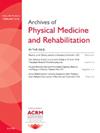Using Integrated Clinical Data and Work-related Traumatic Brain Injury Narratives to Inform Sex-specific Injury Prevention: A Concurrent Mixed Methods Study 8253
IF 3.6
2区 医学
Q1 REHABILITATION
Archives of physical medicine and rehabilitation
Pub Date : 2025-04-01
DOI:10.1016/j.apmr.2025.01.018
引用次数: 0
Abstract
Objectives
To examine sex differences in preinjury Person-Environment-Occupation (PEO) factors and provide recommendations for primary prevention of work-related traumatic brain injury (wrTBI).
Design
Concurrent mixed methods study. The PEO model served as a theoretical framework for analyses of clinical and injury narratives data. We applied a theme-based approach to analyze qualitative data and calculated the proportion of male versus female workers for each PEO factor stratifying by external cause of injury in quantitative data analyses.
Setting
Rehabilitation research—teaching hospital.
Participants
Adult participants (n=93, 51% women, 67% aged >40y) who sustained a wrTBI at least 3 months prior and were referred to a rehabilitation research-teaching hospital for brain injury assessment and management.
Interventions
Not applicable.
Main Outcome Measures
PEO factors implicated in wrTBI.
Results
Qualitative analysis of injury events revealed distinct patterns between male and female workers within 2 themes: (1) nature of occupational activity and (2) physical and/or social load of activity performed at the time of injury. Regarding the nature of occupational activity, more male workers were engaged in direct work activities, and more female workers were engaged in indirect work activities at the time of injury. Regarding the physical and/or social load of activity, male workers sustained injury while operating heavy machinery, and female workers during tasks requiring frequent changes in head position or when interacting with others. Quantitative analysis of injury data enhanced our understanding of these sex differences across PEO factors. We identified statistically significant differences between sexes in terms of employment in specific industries, hours worked per week, and supervisor-worker relationships.
Conclusions
The integration of qualitative and quantitative methodologies in analyzing clinical and injury narrative data facilitated a comprehensive exploration of injury events and enhanced the quantification of sex differences observed across PEO factors. Our results suggest the importance of prevention strategies that address sex-specific occupational hazards, especially in industries that remain predominantly male- or female-dominated, as they expose workers to distinct risks of wrTBI.
This research received funding support from the Ontario Ministry of Labour Research Opportunities Program: Research for Workplace (R4W), the CIHR Institute for Health and Sex (CGW-126580), and in part from Canada Research Chairs Programs (CRC-2021-00074, CRC-2019-00019) and the Global Brain Health Institute (GBHI), Alzheimer's Association, and the Alzheimer's Society UK Pilot Award for Global Brain Health Leaders (GBHI ALZ UK-23-971123). The funders had no role in study design, data collection, decision to publish, or preparation of the manuscript.
Disclosures
none.
求助全文
约1分钟内获得全文
求助全文
来源期刊
CiteScore
6.20
自引率
4.70%
发文量
495
审稿时长
38 days
期刊介绍:
The Archives of Physical Medicine and Rehabilitation publishes original, peer-reviewed research and clinical reports on important trends and developments in physical medicine and rehabilitation and related fields. This international journal brings researchers and clinicians authoritative information on the therapeutic utilization of physical, behavioral and pharmaceutical agents in providing comprehensive care for individuals with chronic illness and disabilities.
Archives began publication in 1920, publishes monthly, and is the official journal of the American Congress of Rehabilitation Medicine. Its papers are cited more often than any other rehabilitation journal.

 求助内容:
求助内容: 应助结果提醒方式:
应助结果提醒方式:


